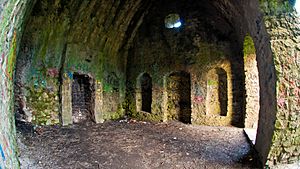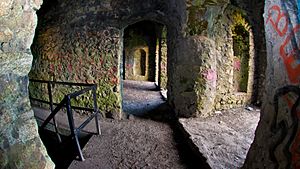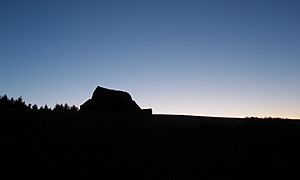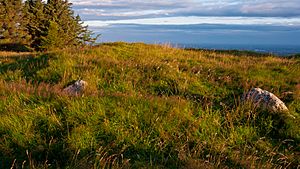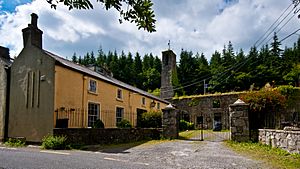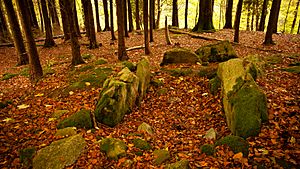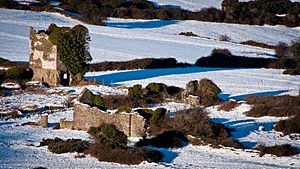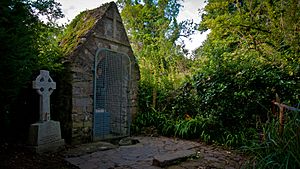Montpelier Hill facts for kids
Quick facts for kids Montpelier Hill |
|
|---|---|
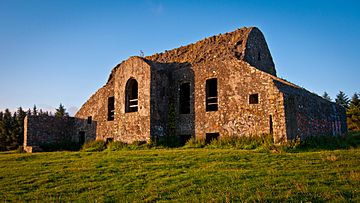
Dawn at the Hell Fire Club on Montpelier Hill, Dublin
|
|
| Highest point | |
| Elevation | 383 m (1,257 ft) |
| Geography | |
| Location | County Dublin, Ireland |
| Parent range | Dublin Mountains |
| OSI/OSNI grid | O120238 |
| Topo map | OSI Discovery No. 50 |
Montpelier Hill (Irish: Cnoc Montpelier) is a 383-meter (1,257-foot) hill in County Dublin, Ireland. At its top sits the Hell Fire Club (Irish: Club Thine Ifreann), which is the popular name for a ruined building. This building was once a summer home. It was built around 1725 by William Conolly, a very important person in Irish politics at the time. He originally called it Mount Pelier. The hill also took on this name.
Locally, the building was known as 'The Brass Castle' and the hill as 'Bevan's Hill'. The original Irish name for the hill is lost. However, one historian thinks it might be Suide Uí Ceallaig or Suidi Celi from an old book called Crede Mihi.
Montpelier Hill is the mountain closest to Dublin city. It is part of a group of mountains that form a ridge around the Glenasmole valley. These mountains include Killakee, Kippure, and Seahan. On the slopes of Montpelier Hill, there is a forest called Hell Fire Wood. It has different kinds of trees like Sitka spruce and beech.
Long ago, there was a pile of stones called a cairn on the summit. This cairn was a prehistoric passage grave, a very old burial site. Stones from this ancient site were used to build the Mount Pelier summer home. Soon after it was finished, a big storm blew the roof off. People believed this was the Devil's work, a punishment for disturbing the old burial site. Because of this, Montpelier Hill has many stories about paranormal events and ghosts.
Members of the Irish Hell Fire Club used the Mount Pelier summer home for their meetings. This club was active from 1735 to 1741. Many stories tell of wild parties and strange practices happening there. These tales have become part of local legends. The building is now almost always called the Hell Fire Club. When the building was damaged by fire, the club members moved to the nearby Stewards House for a short time. This house is also said to be haunted, especially by a huge black cat.
Next to the Stewards House are the remains of Killakee Estate. A large house was built here in the early 1800s by Luke White. His son, Samuel, created beautiful gardens with glasshouses designed by Richard Turner. The estate later went to the Massy family. They used the house for hunting parties and social events. However, the Massy family lost their money in the early 1900s. Hamon Massy, the 8th Baron, was forced to leave Killakee House in 1924. He became known as the "Penniless Peer." After he left, Killakee House was torn down, and the gardens became ruins.
Today, Montpelier Hill and the surrounding lands, including Killakee Estate (now called Lord Massy's Estate), are owned by the State forestry company Coillte. They are open for everyone to visit.
Contents
Exploring the Past: History of Montpelier Hill
The Hell Fire Club Building
William Conolly's Hunting Lodge
The building known today as the Hell Fire Club was built around 1725. It was a hunting lodge for William Conolly, who was a very important leader in the Irish government. Conolly called it Mount Pelier. Over the years, it also got names like "The Haunted House" and "Conolly's Folly." It was one of several special clubs called Hellfire Clubs that existed in Britain and Ireland in the 1700s.
Even though the building looks rough now, it was designed in a fancy style called Palladian. The top floor had a main hall and two rooms for guests. On the east side, there was a third floor made of wood where people slept. Downstairs, there was a kitchen and rooms for servants. The main entrance was on the upper floor, reached by a long set of stairs that are now gone. On each side of the building, there was a room with a slanted roof. These might have been used to keep horses. A stone block for getting onto horses can still be seen. In front, there was a curved courtyard with a low stone wall. The house faces north, looking over Dublin and the flat lands of Meath and Kildare. Conolly's main home, Castletown House, could be seen from here. The land around the lodge was a large deer park of about 1,000 acres. We don't know who designed the building. Some think it might have been Edward Lovett Pearce, who worked for Conolly on other projects.
There was an ancient burial site at the top of Montpelier Hill. Stones from this site were used to build the lodge. A nearby standing stone was even used as the lintel (the stone above the fireplace). Soon after the lodge was finished, a big storm blew the original slate roof off. People believed this was the Devil's revenge for disturbing the old burial mound. Conolly then had a new, arched stone roof built, like a bridge. This roof is still there today, even though the building has been empty for over 200 years. It even survived being set on fire with tar barrels when Queen Victoria visited Ireland in 1849! The lodge wasn't used much, as Conolly himself died in 1729.
The Hell Fire Club's Meetings
The Irish Hell Fire Club started around 1737. It was founded by Richard Parsons, 1st Earl of Rosse, and James Worsdale. Lord Rosse was probably the club's leader. We know some members from a painting by Worsdale called The Hell Fire Club, Dublin. It shows five members sitting around a table. Most of their meetings happened in Dublin city at the Eagle Tavern. Stories say members drank "scaltheen," a mix of whiskey and hot butter. They also left an empty chair at each meeting for the Devil. The club's special animal was a black cat.
The Club at Montpelier Lodge
At some point, the Conolly family rented the lodge at Montpelier to the Hell Fire Club. (Interestingly, William Conolly had bought Montpelier Hill from Philip Wharton, 1st Duke of Wharton, who started the very first Hell Fire Club in 1719.)
It's not clear how much the Hell Fire Club actually used the building. Some think that because it was so far away, there aren't many true stories about what happened there. However, many tales about the building have become local legends. Some of these stories even appeared in books in the 1800s.
One famous story tells of a stranger who arrived at the club on a stormy night. He was invited in and joined the members in a card game. One player dropped a card and looked under the table. He saw that the stranger had a cloven hoof (like a devil's foot)! At that moment, the visitor vanished in a ball of flame. This story is very old and similar to one told about Loftus Hall in County Wexford.
Another tale is about club member Simon Luttrell, Lord Irnham. He was once the Sheriff of Dublin. The story says Luttrell made a deal with the Devil: his soul in seven years in exchange for his debts being paid. But when the Devil came to Mount Pelier lodge to collect, Luttrell tricked him and escaped.
At some point, the building was damaged by fire. There are different stories about this. One says the club members set it on fire when William Conolly's son wouldn't let them rent it anymore. Another says they did it to make the building look more "hellish." After the fire, the club moved down the hill to Killakee Stewards House. However, the club's activities slowed down after this.
The Irish Hell Fire Club started up again in 1771 and was active for another 30 years. Its most famous member was Thomas "Buck" Whaley. This new group was called "The Holy Fathers." They also met at Mount Pelier lodge. When Whaley died in 1800, the Irish Hell Fire Club ended.
What Happened After
An old traveler named Austin Cooper visited the house in 1779 and found it falling apart. Joseph Holt, a rebel leader, wrote in his memories that he spent a night in the ruins of Montpelier after the 1798 Rebellion. He felt safe there, despite the spooky stories. The Conolly family sold the land to Luke White in 1800. It then passed to the Massy family. When the Massy family went bankrupt, the land was bought by the State. Today, Coillte takes care of the building and the forests on Montpelier's slopes. They have added concrete stairs and safety rails.
Ancient Burial Sites
The remains of the very old monument that stood at the top of the hill can be seen behind the Hell Fire Club building. Austin Cooper described it in 1779. He said it was a circular mound about 34 yards across, made of small stones with large stones around the edge. In the middle was a huge stone, 9 feet long and 6 feet wide. This shows that the central part of the monument, which was a passage grave, was still there even after Mount Pelier was built. Some historians think many stones were taken away to build the Military Road in the early 1800s. Today, only a circular mound about 15 meters wide and 2 meters high remains. There's a dip in the middle where the burial chamber was. Four large stones at the edge are all that's left of the original boundary stones. Nearby is another small mound with an Ordnance Survey marker. Close by is a fallen standing stone, a pointed rock about 1 meter high.
However, in October 2016, a new dig found a huge passage grave, like the famous one at Newgrange. It probably dates back 5,000 years and is hidden under the ruins.
The Stewards House: Another Haunted Spot
Further down the hill, along the Military Road, is a two-story house called The Stewards House. It's also known as Killakee House, but it's not the same as the big Killakee House that was torn down. The Conolly family built it around 1765 as another hunting lodge. Over the years, it was used as a home for a widow or for the person who managed the Killakee Estate. At the back, there's a bell tower. These were common on large farms to call workers for meals. The Hell Fire Club met here for a while after the fire at Mount Pelier lodge. This house is also known for being haunted, especially by a large black cat. Stories say the cat is linked to a priest who tried to get rid of a cat spirit at the Hell Fire Club. Another story says it's a cat that was set on fire by club members and escaped across the mountains.
The most famous hauntings happened between 1968 and 1970. Newspapers reported on Mrs. Margaret O'Brien and her husband Nicholas, a retired police superintendent, who were turning the house into an arts center. Workers often left because they said they saw ghosts. One night, a friend and two workmen saw a ghostly figure and a black cat with glowing red eyes. The friend even painted a picture of the cat. Even though some locals didn't believe the stories, more strange things were reported. People saw a ghostly Indian gentleman and two nuns. There were also reports of bells ringing and objects moving by themselves. In 1970, a TV crew made a documentary at the house. In it, a person who could talk to spirits communicated with the house's ghosts. In 1971, a plumber found a small skeleton in a grave in the house. It was likely a child's skeleton. The house was a restaurant in the 1990s but closed in 2001. Now, it's a private home.
Killakee Estate: Lord Massy's Lands
On the other side of the Military Road from Hell Fire Wood and the Stewards House are the remains of Killakee Estate. It's now called Lord Massy's Estate. These lands were first given to Walter de Ridleford after the Norman invasion. Later, they went to Sir Thomas Luttrell, an ancestor of Hell Fire Club member Simon Luttrell, given by Henry VIII. The Luttrell family owned the estate until the 1600s. Then it passed to William Conolly. In 1800, the Conolly family sold the estate to Luke White.
The White family built Killakee House on the estate in the early 1800s. It was a large, two-story house with 36 rooms. Luke White's son, Colonel Samuel White, inherited the estate in 1824. He worked hard to develop the gardens. In 1838, he hired Sir Ninian Niven, a famous garden designer. Niven created two fancy Victorian formal gardens with gravel paths, terraces, and exotic trees. There were also statues of Greek and Roman gods. Near the house was a rose garden with a statue of Neptune. Another walled garden in the woods had more fountains and glasshouses designed by Richard Turner. A writer in 1864 praised the gardens, saying they showed how well planting and draining could improve a barren area.
When Samuel White's wife, Anne, died in 1880, she left the estate to her husband's nephew, John Thomas, the 6th Baron Massy. The Massys were a powerful family who owned a lot of land in Ireland. Massy used Killakee House to entertain guests who came to hunt on the nearby mountains. He also hosted parties during big events in Dublin, like the Dublin Horse Show. Long lines of guest carriages would stretch along the road to the house. However, due to less money coming in and bad investments, John Thomas Massy was in a lot of debt when he died in 1915. By the time his grandson, Hugh Hamon Charles, the 8th Baron Massy, inherited the estate, the family's money problems were too big to fix. In 1924, he was declared bankrupt and forced to leave Killakee House. The Massys first moved into the Stewards House, then to a small cottage on the estate. Hamon Massy, unable to find a job, relied on his wife's small salary. Until his death in 1958, Hamon Massy, known as the "Penniless Peer," was seen collecting firewood in the woods of his old family estate.
After the eviction, Killakee House was briefly used by the police in 1931 to hunt rebels. When the bank couldn't find a buyer for the estate, a builder bought it. He took everything valuable from the house and then tore it down in 1941. The land was eventually bought by the State and opened to the public. In the late 1930s, a German forestry expert created a forest in the area. The trees have now covered most of the land where the fancy gardens once were. Only the brickwork of the glasshouses and the old water system remain.
In 1978, an archaeologist found the remains of a prehistoric wedge tomb in the woods. Only the outline of the main chamber and outer walls are left. Most of the stones were used to build a low stone wall in front of the tomb.
Carthy's Castle: Another Ruin
On the northern slopes, there's another ruined building called Carthy's or McCarthy's Castle. This is all that's left of Dolly Mount, also known as the "Long House." It was a large hunting home built by Henry Loftus, Earl of Ely, in the late 1700s. The building was originally two stories high with curved windows. It had the Ely family's coat of arms above the door. On each side of the house were arched gates leading to other buildings, ending in a three-story tower with a battlement top and pointed windows. The inside was known for its marble fireplaces and decorated ceilings. The Earl's first wife was the aunt of Dorothea "Dolly" Monroe, a famous beauty. The house was named Dolly Mount in her honor. The Elys later left the house, and it soon fell into ruin. A tenant named Jack Kelly damaged the house to make sure he wouldn't be disturbed. Everything except the tower on the western end, now called Carthy's Castle, was torn down in 1950.
Orlagh House and St. Colmcille's Well
Next to Carthy's Castle is Orlagh House. The Augustinian Order has owned it since the mid-1800s. It's a retreat and conference center run by the friars. It was built in 1790 by Mr. Lundy Foot, a rich snuff merchant, who named it Footmount. He was also a judge and helped sentence three members of the Kearney family to death for a murder in 1816. Foot himself was murdered in 1835. This act was thought to be by relatives of the Kearneys. Actually, Foot was killed by James Murphy, the son of a farmer whose land Foot had bought after the farmer was forced to leave.
In 2017, Orlagh House was sold to a private buyer. With fewer people joining the Church, it was no longer practical for the small group of older Augustinians to live in such a large house.
In a field across from Orlagh House is a holy well linked to Saint Colmcille. A statue of the saint was put there in 1917. People who visit either drink the water or put it on sore ears.
Visiting Montpelier Hill
Montpelier Hill can be reached from the Hell Fire Wood car park. This car park is along the R115 road between Rathfarnham and Glencullen. The woods have about 4.5 km (2.8 miles) of forest roads and paths. Lord Massy's Estate is also accessible from the R115 road, near the Hell Fire Wood car park. The woods offer a nature trail and a permanent orienteering course. Lord Massy's Estate and Montpelier are also part of the Dublin Mountains Way hiking trail, which goes between Shankill and Tallaght.
Future Plans for the Area
In March 2017, plans were announced for a big project called the Dublin Mountains Project. This project, by South Dublin County Council, Coillte, and the Dublin Mountains Partnership, would develop Montpelier Hill and the Hellfire Club site. It includes new parking, a cafe, a treetop walkway, better trails, and a Visitors Centre.
However, local residents and community groups are against the plan. They are worried about the delicate natural environment, possible damage to recently found ancient artwork, and traffic jams from an estimated 300,000 visitors. These groups have started a campaign called "Save the Hellfire" to try and stop the project from getting approval.



